Text
Academic Excursion
On my free day that was filled with temples after doing some digging I found that all the temples followed different sects of Buddhism. The first temple I went to was right across from our hotel and followed True Pure Land Buddhism. The temple was large and while the outsides of the building were simple, the inside was rather opulent. Beautiful gold plaques lined the roofs walls, and the center of worship itself was quite large (and equally covered in gold). Most of the individuals practicing were older, and while I’m not sure what exactly they were praying for some of the clothes they worse seemed like attire one would wear when mourning the dead. Next I travelled to Ryozen Kannon, which follows Pure Land Buddhism (an earlier form then True Lure Land). This temple was almost completely empty so I couldn’t gauge the type of people who worship here. However, this temple was one of my favorites as it serves as a memorial for the lost war dead of WW2. Whether that soldier was Japanese or American you can find their name there, and this for me shows the power of Buddhism. It can break that boundary created by a brutal war for the sake of paying respect to those who died irrespective of which side they were on. Within this complex many smaller temples could be found on surrounding paths. Sadly these were much smaller I was unable to figure out what sect they followed.
What was clear from my time walking around was the wide variety of worship at these many different locations. While a majority of the individuals were older, at some of the smaller shrines I tended to find more young people. This may be the case because one of the temples I visited was focused on love. However, the two largest temples I visited follow old “traditional Buddhism” and in this is in line with the reading I selected for this day. I feel (especially after the reading) that such a generalization is too broad, at least with the limited knowledge I have at my disposal. What the reading taught me, similarly to the reading about Inari, is that for a portion of the society Buddhist practices are very much internal and sort of created within oneself.
This contradicts with the major literature on Buddhism (the articles main concern) as academia tends to view Buddhism through a sectarian lens. What is lost through this lens is the regional variants and practices done throughout time. In an effort to likely make discourse on Buddhism more streamlined, academia chooses to focus on the major sects (which tend to be older) when writing about Buddhism. In a way this type of behavior forces Buddhism into a mold refusing the fluidity that seems to be a major point of religion in Japan.
The article also shows that the younger generations within the country actively engage with Buddhism, even though it may not be in the level of their older relatives. Of interest to me was the description of a group of Buddhist priests under 45 (young in this context) who are looking forward for new ways of expanding Buddhism, rather than leaving it stagnant or even dead as some critics would describe it. This reflected reality in the first temple. While the oldest monk (who seemed the most senior) lead the event, on all his flanks were younger priests presumably in training to continue the torch. I’m not sure why anyone would deny Buddhism as a “live” religion. The only reason I could see someone reaching this conclusion is because it didn’t match the expectation from a film they may have watched (or popular ideas they had).
Covell, Stephen G., and Mark Rowe. “Editors’ Introduction: Traditional Buddhism in Contemporary Japan.” Japanese Journal of Religious Studies, vol. 31, no. 2, 2004, pp. 245–54. JSTOR, http://www.jstor.org/stable/30233761. Accessed 22 June 2023.

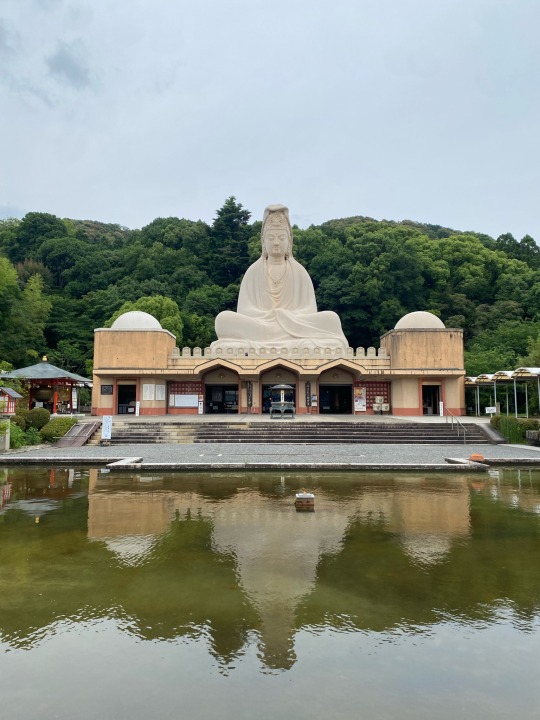
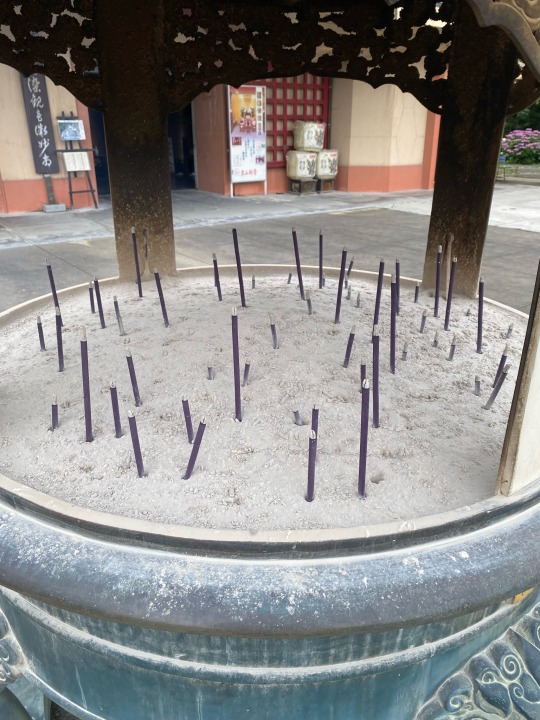
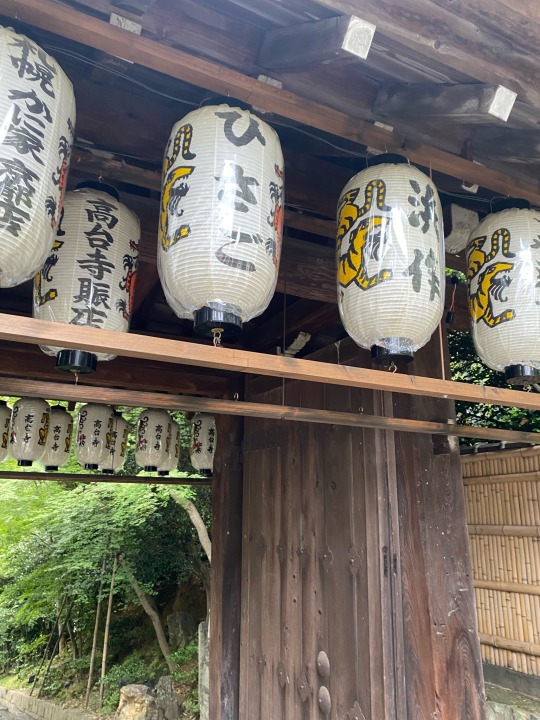
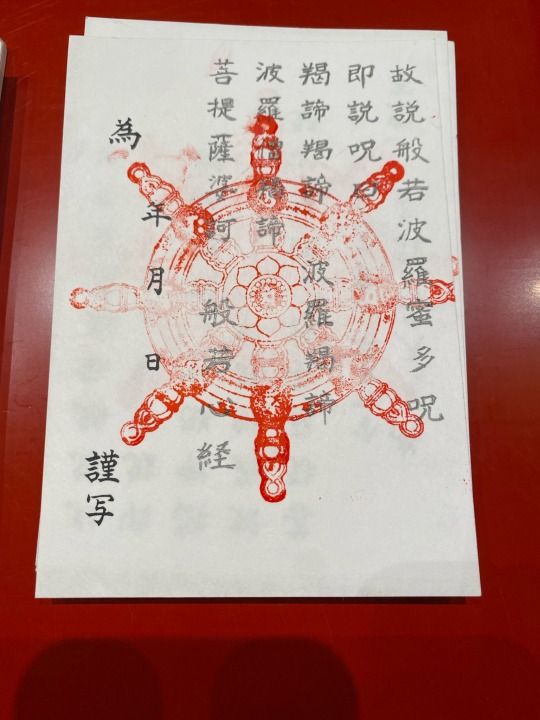
3 notes
·
View notes
Text
June 20 - Osaka Day Trip
A couple of my peers in our group had already been to Osaka, and each one of them only came back with glowing reviews. I was pretty excited in the morning as we departed, and upon arriving the city reminded me a bit of Tokyo. Significantly fewer people, but tall buildings and more energy compared to a city like Kyoto. The first thing we did was break for lunch since the train ride was about 2 hours long. I went to probably one of the best curry spots I've been to in Japan, a fusion of Japanese and Indian curry. At this location (which was entirely staffed by one man) the chef offered a Whimiscal Curry of the Day, which I found out was fish so that's what I ordered. It was delicious, and I only wish there was more on the plate. I also ordered a mango lassi which he hand-made in front of us. After that, we regrouped and traveled to Osaka Castle. While we didn't go inside as it has been refurbished with a modern aesthetic the outside was quite beautiful. After we traveled to Ameri Village, which was a burgeoning little district mainly filled with second-hand clothes retailers and well-dressed youth. We didn't stay long as our tour guide Leina was nervous about the location (but I eventually came back later and did some shopping). We then went to this area which looked like a smaller-scale version of Time Square. As we walked down the rode, many many shopping carts and restaurants lined the street. I wasn't very hungry even though Osaka is the food capital of Japan. After doing a good bit of shopping I went to the Botanical Garden exhibit held by TeamLABS. Honestly, it was kind of meh just some pretty lights in a wooded area. Afraid to miss the final train Eliza, Nico and I left the group early to return to the hotel. To finish the night off I went to the onsen down the street alone and had a nice soak.
Academic Reflection
Our reading for Osaka dealt with urban planning. It reinforced the knowledge we had gained from the previous reading on Tokyo’s urban planning such as the effect loose building codes and overall layout had on the cities effect. As I stated above both cities mirrored each other which was a welcomed pace of change compared to the general slowness of Osaka.
What I’ve come to appreciate about Japan’s construction is how each area is evidently suited to the people that live there. This was more so the case in Tokyo where districts were more clearly delineated. However, beyond just making the city walkable and accessible different areas serve particular functions.
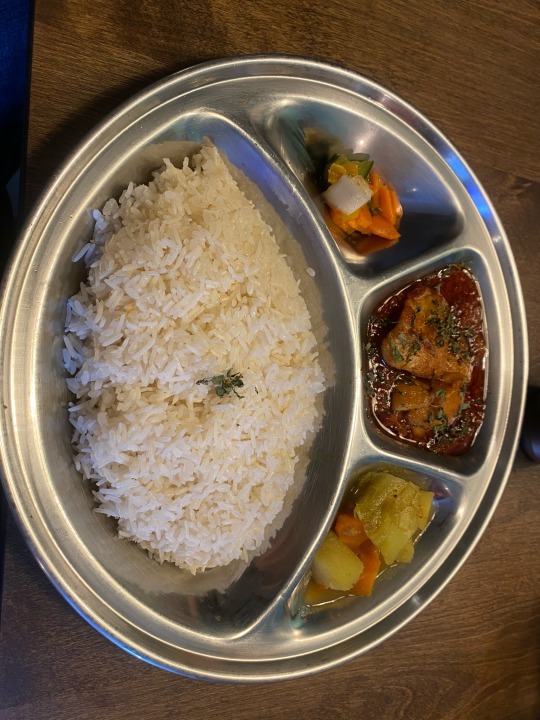


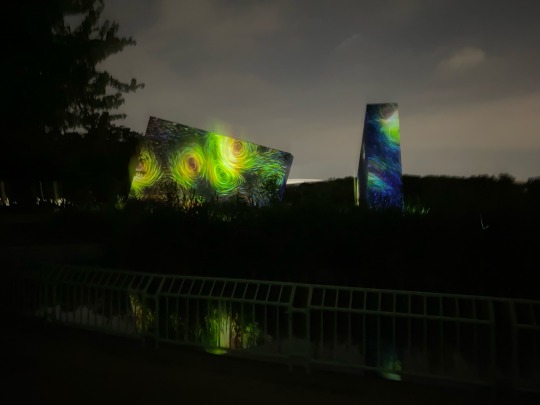

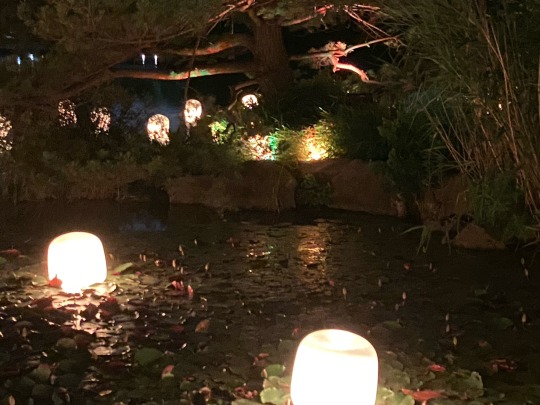
2 notes
·
View notes
Text
June 19 - Nara Day Trip
I’m tired of talking about my morning so I’ll just jump into the meat. We took a train to Nara today, the old old capital of Japan. Nara had the same vibe as Kyoto, filled equally with museums and temple/shrines showing the history that resides within the place. Before we went on any excursion we are in the city. Vishnu and I ate some yummy ramen, with a different type of broth that I had never seen before (it was thick and brown). I also ate some fried rice for the first time in Japan and it was wonderful. After we ate, we went to Todai-ji a massive temple housing multiple large statues housed within. In the center was the biggest metal work I think I’ve ever seen, with insane precision and attention to detail throughout the whole work. On both sides were slightly smaller wooden figures. The wood crafting of Japan must have been next level and to think these were made in the Nara period (while they are remade since the structure has suffered destruction it’s meant to mirror the past constructions). After we went to the museum on site, and here we were able to see actual statues from the 7th century. I really loved this museum as it exclusively had items from the Nara period, and the craftsmanship is really awe inspiring. After we went to a shrine (the name is lost on me). This shrine had a 1000 year old tree, and it is built into a structure. However, the coolest part of this shrine was a long hallway only lit by lanterns. The walls were mirrors giving the illusion of infinite lanterns. Once we finished with the excursion the boys and I left back home. We hit the onsen together and it was a beautiful experience (I missed it so much). After we went to Shake Shack and grubbed like absolute kings.
Oh man how could I forget. Before any temple we went to a park filled with sacred deer! These deer were quite friendly and hungry. You could buy crackers for about 200¥ and they would flock to you demanding snacks. While everyone was dumb enough to have the snack in hand I put them in my pockets and fed only those that I deemed worthy. I found a cool stag, who’s name is Cole and feed him a majority of my crackers. After our interaction he proceeded to rub his antlers on my legs, which I found out is how deer mark so he must have accepted me into his deer clan. Cole was sick as fuck and let me pet him for a while.

Academic Reflection
The many sects of Buddhism in Japan honestly make the religion even more daunting to jump into. Before I came to Japan I was thinking about purchasing a book and diving in but I quickly found out no central text exists for Buddhism (like there is for Christianity). After coming to Japan it has become clear why, and Japan isn’t even the originating country of Buddhism. I couldn’t imagine how many more different sects exist from Korea, to China, and finally to India (only going linearly). While I still have an interest in jumping into Buddhism, it will take some more research to find the proper book to start off with.
I for sure won’t be getting into the type of Buddhism as described in the readings today. I am much more concerned with spirituality as it deals with the real tangible world, and not with whatever cosmic powers esoteric Buddhism dives into. That’s why I’ve really appreciated the majority of temples we’ve gone to as they are dedicated to Kannon, who is meant to help in this current life. Heaven, or reincarnations don’t particularly concern me.
What I did find interesting was the exacting detail for Kokui life from early youth to the end. I’ve noticed that the reverence held for high ranking priests/monks almost falls into idolatry, but then I have to remind myself that the faiths of the West and the East are very different. Individuals practicing Buddhism can achieve godhood through worship alone, and that provides other potential slip falls in my personal opinion.






3 notes
·
View notes
Text
Media Reflection - Blue Giant and Live Jazz
For two of my free days while I’ve been in Japan I went out to local Jazz bars. One in Tokyo (Pit Inn), and the other in Kyoto (Zac Baran) I was treated to wonderful live performances done by “amateur” musicians. I put amateur in quotations as I do not mean it in any detractive sense. The people I heard play weren’t professionals but the passion for music was evident in every single one of them. The first bar in Tokyo was a sort of open mic (more like a open stage) event with anyone in attendance being allowed to play. They even asked me but I didn’t have my instrument and I haven’t played in a long long time. A majority of the players at this bar were older, and their experience on their various instruments was evident. The event itself was also on the cheaper side (primarily why I went) but I wouldn’t have wanted anything else as I got to see many different groups of people play one song after another for about 2 hours of sweet Jazz. Near the end of the performances I was even able to hear singers contribute, and while English may not have been their first language they gave it their all. At the second bar, it was a duo and the chemistry between them was tangible. They played off each other the whole night, singing in a Bob Dylan-esque fashion. While it was only a guitar and drums they played a wide range of music (rock/blues/jazz). This performance was completely free, so these two men were playing just for the sake of it and that warmed my heart. Music can be many things, but one of the main reasons I pursue it is for the soothing effect it can have on my own soul. I went to this bar last night, and as we near the end of our trip my own mental health and weariness for home had begun to effect me. These two men helped me quite a bit that night.
The media I consumed back home is the manga Blue Giant! Blue Giant is about a young high school boy who ignites a newfound love and wish for music (specifically the saxophone) after he leads a fairly ordinary life pursuing other hobbies such as sports. The song he listens to that starts him on this journey was by Miles Davis, and the love for the “Blue Giants” from the West is evident at both jazz bars I went to. At Pit Inn large pieces of vinyl held portraits of artists Miles Davis, Nat King Cole (and others) along the walls. The reverence to these artists is clear as the jazz standards each musician had at Pit Inn was filled with the classics created by these giants. The manga holds this same reverence, with certain panels feeling as if the music is infused into them (I would listen to Miles Davis when the main character Dai would play and it felt like he was playing).
However, what came through the most from the manga that I saw in real life was the passion. While professional jazz players exist in Japan, the landscape is not quite the same as it is in the US. While I can’t say this with 100% certainty, conservatories and audiences don’t exist here in Japan on the scale that they do back home. However, that isn’t what jazz is about. Jazz is purely about passion, about the heat of playing. Especially at Pit Inn, where the room was filled with fellow musicians it was clear that no one was restricting themselves. Each song every individual that was part of the piece had a solo, and they just let it fly. Halfway through the night, in the middle of a solo a fellow artist on stage might play a short accent allowing the soloist to go off onto another plane with their music.
The manga also reflected the reality of the age of those who played. While Dai is a highschool student he is largely mentored by older veterans, who only want to see him grow. While some young people played at Pit Inn, it was clear that they were reverent to their senpai (and the oldest gentleman there was the one guiding the event by calling names of those who signed up to play). This feeds into be larger legacy of jazz as an art form, as a tradition that is built upon by generations.
I’m so glad I pursued both of these opportunities. While I haven’t quite finished the manga, I will now return to it with a renewed vigor and appreciation at the reality of live music in Japan that it presents.
PS: Fun find at the Kyoto Manga Museum was a mold of mangaka Shinichi Ishizuka who authors Blue Giant. You can see a photo of it all the way at the bottom of my post.




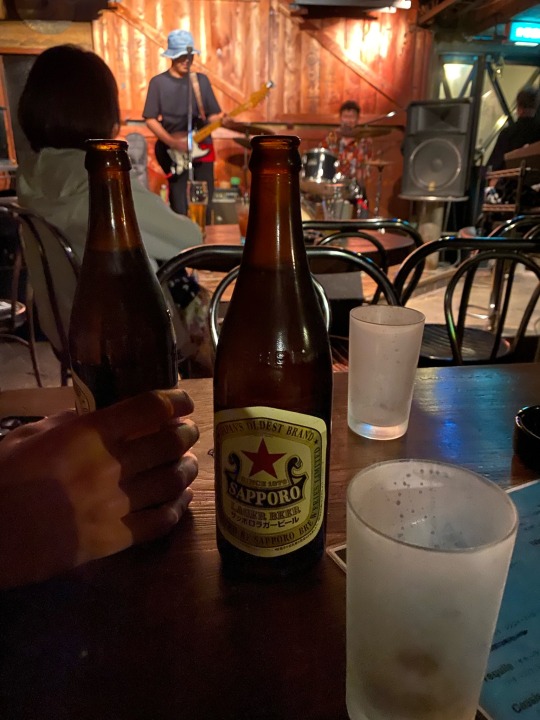
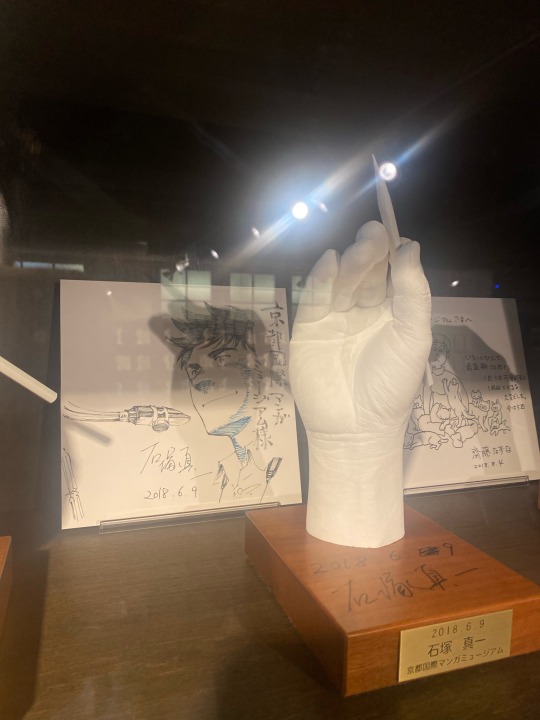
1 note
·
View note
Text
June 18 - Kyoto International Manga Museum
Today is the day I’ve been looking forward to the most. It felt like I was traveling to the Mecca of my hobby, and while I received no divine visions for my cross world pilgrimage here it was still amazing. The museum presides within a old elementary school, and basically functions as a massive library housing manga as early as the Prewar period. Recently back home I found a copy of Tank Tankuro which is the only Prewar manga I own, and it was so nice seeing it on the shelves here among the few Prewar books that have been collected by the museum. While I don’t understand Japanese just by opening up a random book and flipping through the pages I continue to be in awe at the range of topics, art, and storytelling tackled by manga. While I love films, I feel like manga (and comics by extension) are a unlimited art form not bound by funding or feasibility of creation. You can make any image and any story you want. Thankfully the gift shop wasn’t to alluring (I was seriously worrying) but I did end up finding the first volume of Hokusai manga (the second I found on our first day) so now I have about 800 pages of his beautiful prints. While I know he isn’t connected to the manga I read today, I would still argue inspiration exists at least in the visual aesthetics pursued through Japan (which I love). At the museum we were also treated to a kamishibai performance, which are paper plays voiced by an operator who manipulates images in a small screen. This can be seen almost as a precursor to manga, before humans were able really conceptualize sound image. Once the performance ended my whole class left, but I saw that in the English library they had volumes of Phoenix which can reach hundreds of dollars. With this in mind I stayed for about an extra 2 hours reading what is considered Tezuka’s masterwork. In all honesty it just wasn’t for me. At one point a character stabs another, while declaring his love for her. As she bleeds out they make out and I just had to put it down for a bit. I ignored my hunger while reading but once I left I quickly ran over to the Sukiya across the street which provides quick food at a questionable quality. In preparation for our day trip I chose to rest for the day, finding a yummy French bistro which was equally as affordable but way better.
Academic Reflection
Reading this paper was like butter. It took me about 30 minutes, but I guess that’s what happens when it’s about something you love. I was truly surprised at the quality of this writing, as some papers I’ve read have been really hit or miss. This paper not only provided a wide range of arguments about the possible origin of manga (correctly citing Bringing up Father, which the book Comics and the Origins of Manga by Eike Exner which I’ve been reading also cites) but also described why these arguments exist. I found this of particular interest, as those who argue for mangas connection to ancient Japanese art forms do so in an attempt to legitimize manga as important to Japanese culture. This is because (similarly to video games in the West) manga has been demonized by the broader society as a sort of deviant activity which promotes further deviant behaviors. On it’s face this is wrong, but it also gets closer to issues of class that are faced abroad (more specifically in Japan) regarding how those with privilege view art created and consumed by those of a lower class. These individuals may feel frustrated because manga/anime has become a major (if not the main) cultural export of Japan versus its other high art forms like kabuki, noh, etc. I personally find this sad, but as more and more Japanese people consume manga regularly perspectives are bound to continue to change into the future.
Continuing off manga as a low class art, the papers mention of gekiga made me happy. Recently in my own manga collection, I have been diving deep into gekiga with authors like Tadao Tsuge, Yoshihiro Tatsumi and Yoshikazu Ebisu (Yuichi Yokoyama as well however he is part of another gekiga wave). These authors brought a new energy which was vital for the continued evolution of manga into the future. Without names like these (and many many more) I don’t think we would have manga like it is today. Even though I couldn’t read them I flipped through some of these authors book, and the power of their composition/art was enough to follow the stories.
I was also shocked to see how profitable the manga industry is with it reaching into the billions of dollars. The museum and reading broaches the topic of piracy. I couldn’t even begin to imagine the potential profit numbers of piracy for manga didn’t exist on the scale it does (and the scale is truly massive). However, this reading and our past reading on otaku culture show how ingrained into manga culture derivative work/piracy is. Personally, I engage heavily into this community reading leaks for manga like Jujutsu Kaisen weekly and reading scanlations of manga that will likely never get English releases (I value reading manga physically so I will wait if the possibility exists). For manga like Jujutsu Kaisen I purchase the volumes on release in the West, and I think this is why piracy is allowed. Not only would it be very difficult to crack down on all the scanlation teams (manga publishers would likely have to invest into groups of lawyers which would be costly), but they effectively act as free advertising. While this may be a divisive take for people who are hardline on intellectual property law, I think manga would exist as an interesting case study when a medium and this underbelly synthesis together.
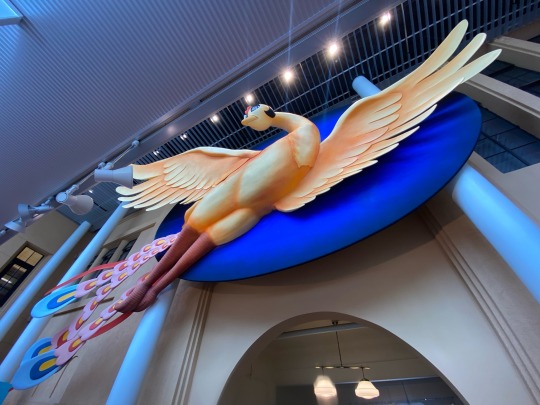

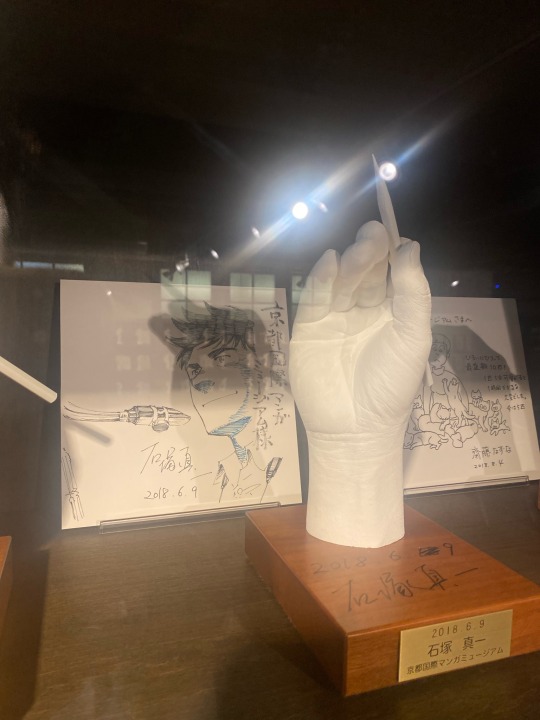
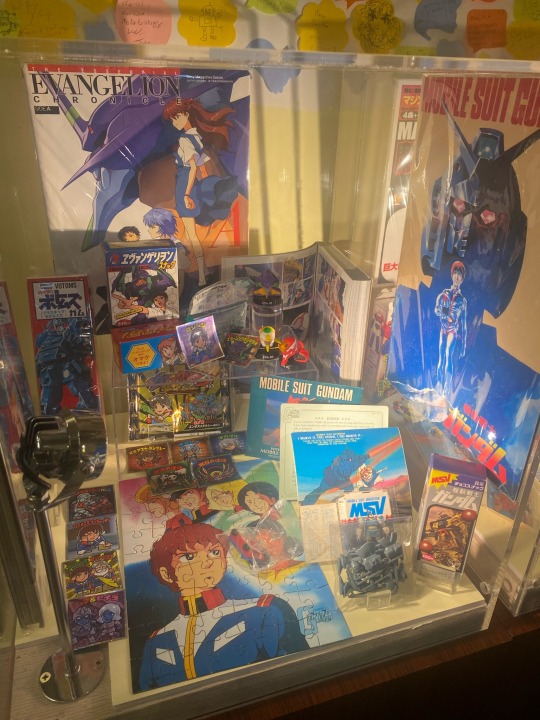


1 note
·
View note
Text
June 17 - Free day=Live Music Day
In order to restore myself for the last couple days here, I slept in until around 5 PM only leaving to check out a pop up market and get some Japanese curry (the best). I’m not sure if my issue is a physical energy issue, and might more so be a mental energy issue. However today I think I alleviated it with some live music which I appreciated with my boys Nico, Raj and Zander. I found this spot, hosting a two piece rock/jazz band which was for free! We all purchased some drinks and food to counter that. The beers were massive (only one has me a little tipsy as I write this). The music was fierce as these guys played their hearts out, and I’m so happy I found this little spot. We listened for about an hour and a half but soon after the boys started to get hungry so we left. Together we found this sick as Mexican restaurant (which we are now at) in a basement. The food smells amazing, the Japanese waiter speaks Spanish and we are currently waiting for our food. I’ll come back and update this once we start eating.
The food was great, I demolished the tacos and enchiladas. I got this chili and that wasn’t the best but I had been craving Hispanic flavors for a while now so it was nice to have some of it before I got back. After eating we finished the night at a shisha bar, and it was my first time trying it (trying nicotine for that matter). I thoroughly enjoyed it, and the conversations we shared were very enjoyable. I feel rejuvenated.


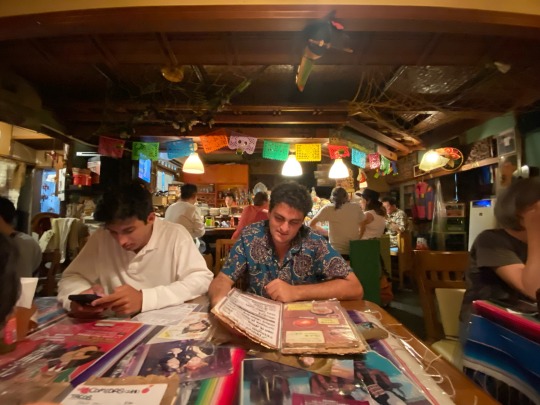

1 note
·
View note
Text
June 16 - Arashiyama Bamboo Forest and Monkey Park
My energy continues to erode day after day. Doing the readings this morning I could barely keep my head straight, but somehow I was able to get through them all. Our first excursion took us to Arashiyama Bamboo Forest a scenic area densely full of foliage. However, the area was smaller than I expected and was filled with way to many people. Honestly the area around it, which was in a large river was more beautiful. Various rowboats paddled along the river and the breeze provided by the water was necessary as it was extremely hot today. Along the river Nico, Zander, and I found a little hole in the wall serving up deliciously greasy yakisoba for only 750¥! I also found a yummy ice yogurt drink (called a granita) that was also refreshing that I enjoyed with Zander. After that we left for the Monkey Park and they were so cute! The sanctuary is quite small, but the view up from the mountain was expansive. For 50¥ we were able to buy some peanuts to feed the monkeys with, and I managed to feed a little baby. Now I’m going to the RB with my pals. Not much of a day, but I’m excited for 18th as we go to the Manga Museum!!!
Academic Reflection
The favorite thing I learned from the readings today was that “Urban and suburban forests are very important in comprising the local landscapes of Japan, where roughly 68% of the total land is covered by forests.” I wish we could have this back in the States. Whenever we are on the top of a mountain this statistic becomes validated as basically anything that isn’t a building is instead a tree. There are even dense pockets of trees in the middle of the cities. I was confused though because the reading described evergreens existing in the forest but all we saw were bamboos.
Our other readings pertained to the Tale of Genji, with scenes located at the Nonomiya shrine which is in the Bamboo Forest. The shrine was pretty quaint with its coolest feature being the unfinished wooden torii gates. This feature was also described in the chapter we read so it was the first thing I noticed. The Tale of Genji readings didn’t really provide anything academically, and only served to paint the courtesan class in a further negative light for me. They “speak” to each other in poems, choosing such roundabout ways to engage with each other. However I did enjoy the prose style of the Tale of Genji, which elaborately describes the psychology of each character and the surrounding environment.
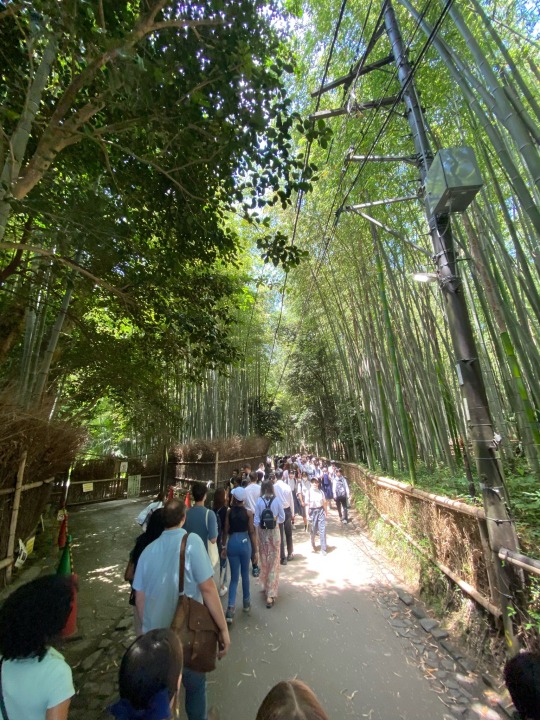

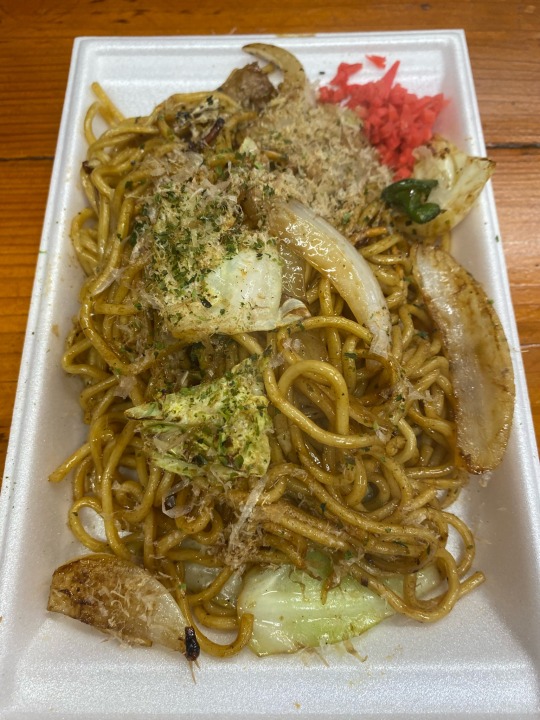
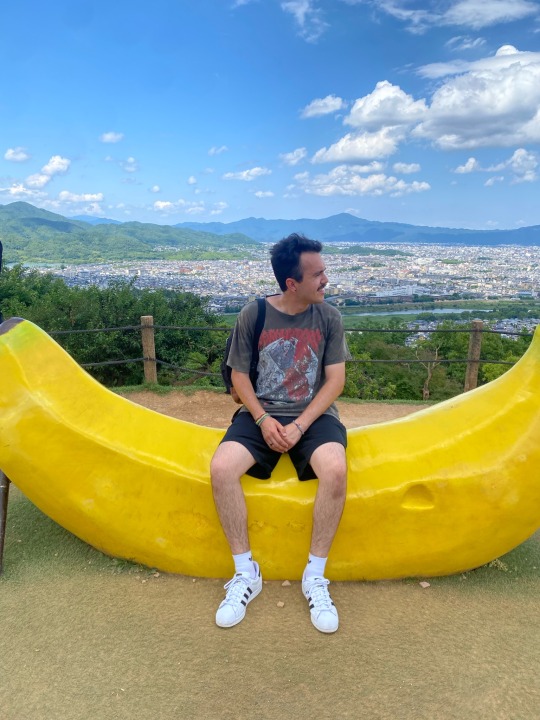
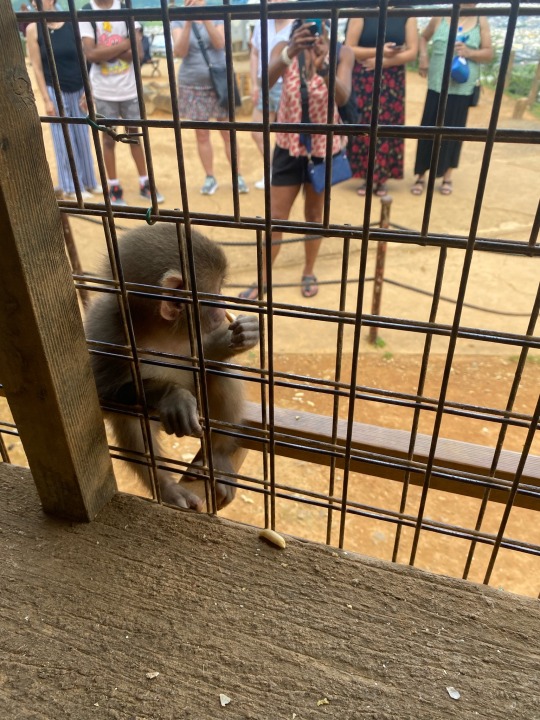

2 notes
·
View notes
Text
June 15 - Kyoto National Museum and Imperial Palace
Today is probably the roughest day I’ve had since I got here. My sleep continues to erode, and the early breakfast time of 7:30 makes it harder each day. With a worse transportation system we do much more walking in Kyoto, and while I love walking it is becoming increasingly taxing. The first location we went to was the Kyoto National Museum, which was a small but beautiful museum. While the exhibitions weren’t as large as the Tokyo National Museum, I felt like some of the items were more impactful in Kyoto (perhaps due to the museums incredibly dark ambience, with lighting focused on the items). This was particularly the case for the statues, which were not only bigger but more dynamic. What shocked me the most was that most of them were wood carvings as the statues here were quite large (sadly we couldn’t take any photos in the museum). The bar for artistry in ancient Japan continues to raise in my mind, as the craftsmanship whether it be an ironwork or piece of calligraphy really comes through (even though some of these pieces are centuries old). One point of frustration was how much time we had at this particular museum. Even though it was significantly smaller than Tokyo National Museum, we had more time here so I sat around for an hour (even though I read the description of most items and looked at them all). Once we left we broke up for lunch, and the first spot my group of friends went to was closed. We then had to quickly walk to another location, and when we got there it took them about 30 minutes to prepare our food (after they served multiple parties that ordered after us). They didn’t even give me my drink before I was done with my meal which also bothered me. While we thought we would be late, we weren’t the last as we can usually count on a certain group of 3 people to be significantly later than anyone else. From here we took the metro to the Palace. Here we had a guided tour in English, explaining the layout and purpose of the rooms of the palace. The palace wasn’t vertically large (as opposed to Himeiji Castle) but was quite wide. The location was quite nice and my favorite part was the roofing technique used. To create the roofs for the palace, Cyprus bark is stripped off of the tree and stacked into thick slabs. What I really like about it (apart from the aesthetic appeal) is the fact that it is a sustainable practice, as the tree will eventually regenerate the bark allowing it to remain healthy. It can eventually be reharvested provided a renewable resource!
Academic Reflection
Like the Tokyo National Museum, the Professor asked us to seek out one item which spoke to us and focus on it in our reflection. While sadly no photos were allowed the sculpture of Emna, King of Hell struck me the moment I saw it. His fierce face and fiery beard drew me in, and once I saw the marvelous color on him I began to inspect the figure fully. While other statues of Emna I’ve seen have been almost comical to me (the colors tend to me to bright, and his expression is ridiculous) this one truly felt like the “King of Hell”. While he was seated (and was also one of the smaller statues in the collection), he felt the most domineering. What pushed me to write about it was the construction described on the items card. The statues is not only made out of wood, it is made of several wood blocks that were then pieced together. After I found this out I looked again, but couldn’t find any segmentations in the statue so whoever constructed it went to great lengths to make it appear as a single piece. It also apparently had a compartment (perhaps using the King of Hell scared away any would be box openers).
Like the reading describes the palace is mostly unassuming, featuring rather empty spaces that bleed into the nice gardens that are at the back of the palace. The palace itself is quite large, and this was necessary as the life of the ruling class was surrounded on the periphery by many attendants (according to my professor) who did most of the day to day such as cooking, cleaning or really anything not suited for someone of the upper class. While the doors weren’t open (doors on hinges on the top meant to be pushed up) our guide described the insides as completely empty functioning almost like a hall. In all honesty I couldn’t care much for the place, and the reading didn’t really elucidate anything as most of what it described was either not present or not visible.

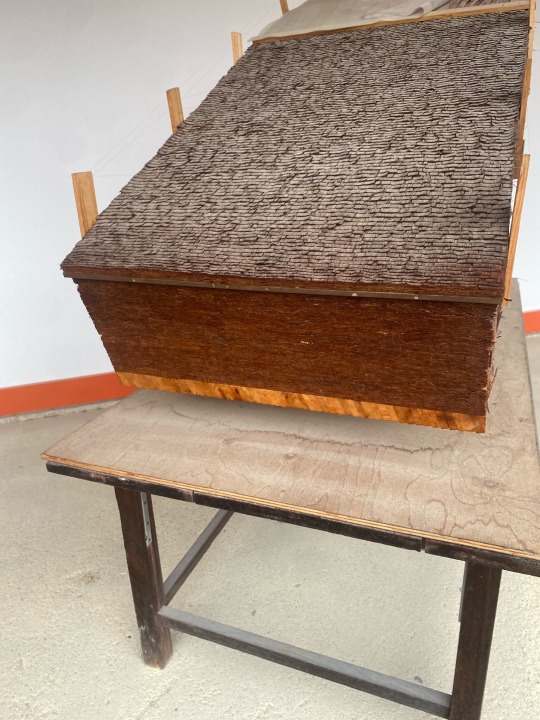
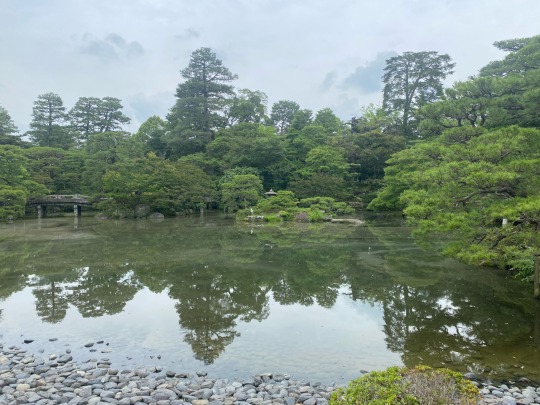
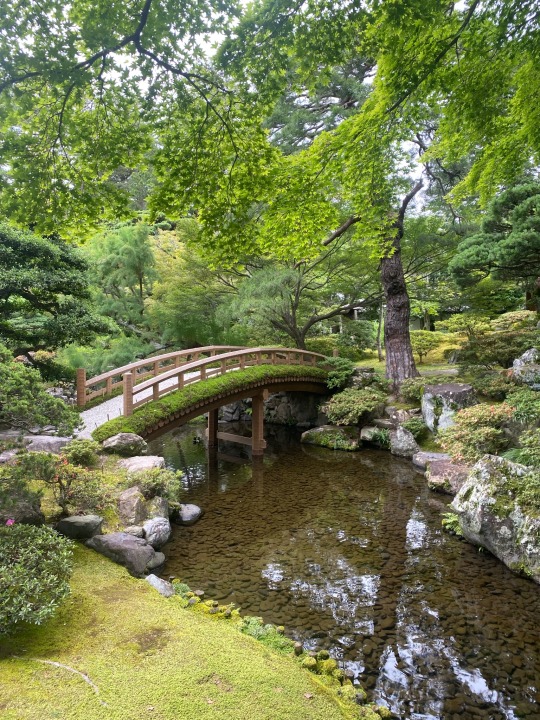
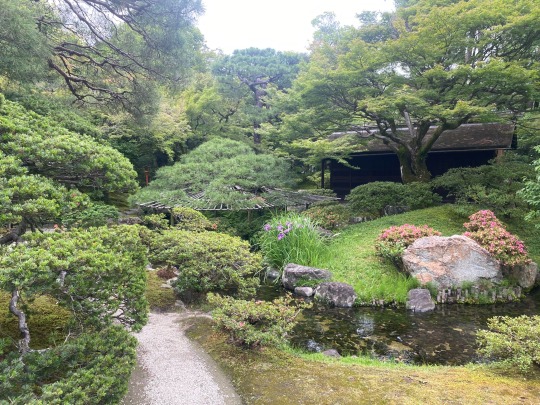
2 notes
·
View notes
Text
June 14 - Fushimi-inari Shrine and Mountain
Breakfast at this new hotel really sucks. The servings are basically baby sized (I’ve seen my 1 year old brother eat more) and it’s because we are now being served “American” breakfast. What was nice today was that the waitress remembered how many servings of rice I would ask for when we had Japanese breakfast so she brought me an extra slice of toast without me having to ask. Todays excursion was another shrine/mountain hike. This particular shrine, called Fushimi-inari enshrines the kami Inari which accounts for about 50% of the shrines all throughout Japan. While Inari exists in both Buddhism and Shinto, this specific location was a Shinto space (that’s why I refer to it as a shrine). This particular location was incredibly scenic with countless torii gates lined up one after another creating a tunnel of sorts. These tunnels covered every route on the mountain, and were donated by various businesses around Japan (as Inari now exists as a kami which benefits business). While we didn’t have to climb the entire mountain for class, I did and was quite disappointed when the peak didn’t offer a nice scenic view. On the mountain, a certain panel from Jujutsu Kaisen occurs which the shrine advertises so I ended up recreating it on my way down! Once we got down I ended up finally trying some gyoza. I ended up ordering two sets of six and some rice, so I think the lady made me a little platter with ramen broth for free so it ended up being a very nice lunch. For dinner I once again had Japanese curry at a restaurant in the Michelin guidebook for Kyoto. I had black beef curry (a first) and it was very very good (probably top 3 Japanese curry, #1 still goes to the 3 old ladies in Hakone). Since I’ve been quite tired these last couple days I didn’t do much else and just retired to my room.
Academic Reflection
Todays reading was quite interesting as it specifically focused on Inari worship in Japan. While Inari might be the most worshipped religious figure in Japan, worship is heavily disjointed with information and practices surrounding it varying from person to person. While religion in the West can be rather split even within the same overall faction (such as Christianity) people in the West can generally agree on who/what “god” is. Here for the kami Inari many, wildly different interpretations exist. For some Inari is a fox, for some a beautiful women and for others an old man carrying rice. Not even do religious institutions agree on what Inari truly is, as no codification really exists for Inari (part of Japan’s sad history of destruction of historical sites). What I really appreciated about the reading was that I made me question what faith truly meant. While I myself am atheist, and have a distaste for religion, most of that distaste is actually aimed at churches for what I feel are manipulative practices. It was refreshing seeing perspectives from both Shinto and Buddhist priests/monks that while a “right” practice may exist (such as Inari not being a fox which is the only thing they both agree on) they were mainly focused on simply spreading information. This painted a much different picture of what faith could look like in my head, versus the very austere images faiths such as Christianity.
Another interesting point came from a disagreement between two monks. Since Inari is practiced by both of Japan’s dominant faiths, the god appears in two different aspects. The disagreement came from the way prayer should be conducted when one is at a different location. The first monk said that if praying at a Shinto shrine, prayers should be given in Japanese otherwise the kami will not understand. A monk countered (not directly, but in private to the author) saying that this is illogical since as a divine entity the kami can understand all languages, and Buddhist sutras are also not offered in Japanese. What I found amusing was wondering if all my prayers have fallen on deaf ears as a result, but I highly doubt it. If a god can’t understand more than one language I’d seriously start doubting their power.





2 notes
·
View notes
Text
June 13 - Free day=Temple day
I had a late start today, but I had a couple temples and shrines I wanted to visit so I just kept my day relatively lax. The first temple was actually right across the street from our hotel and is called Higashi Hongan-ji. The temple is on a large complex with various smaller temples and even exhibits describing the temples history. I came at the perfect time as in the main temple a service had begun so I got to listen to 5 monks chant their sutras. I happened across a Takehiko Inoue art print at the gift shop for the temple (my favorite mangaka) so that was an awesome and unexpected find. After that I quickly made my way to the Ryozen Kwanon temple, which is home to the lost war dead (of all countries) from WW2. The temple was a somber place, and behind the main temple there is a building that houses files with the name of those war dead. While the Japanese may have been our enemy at the time, my heart still feels for the young men who had to put their lives on the line for reasons beyond their control. I also walked through the womb of Kannon, which exists as a 80 foot tall statue at this temple. Like the first temple I went to Ryozen Kwanon was part of a larger complex of temples so I visited many others before finishing my journey at a 8 panel display of Nirvana. Here I learned how to do Zazen breathing, and even wrote a sutra out which I offered to Buddha in prayer. Each time I prayed I asked for help in this current life, with our climate specifically asking for protection for my brothers and the children of their generation.

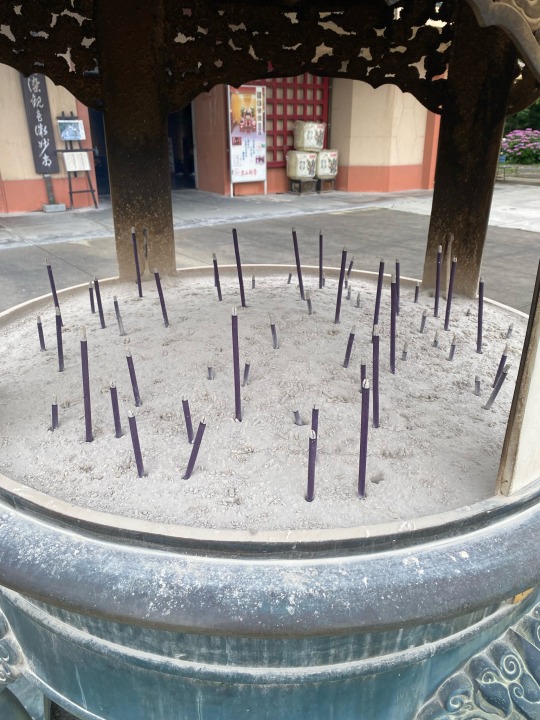



3 notes
·
View notes
Text
June 12 - Kiyomizudera and Gion
Sadly the public transit isn’t the best here (or the best for 28 people to try to use all at once). The buses were packed once more so we had to walk to our destination. The first place was Kiyomizudera which was tucked away in a outcrop at the halfway point of a mountain. His appearance is rather dubious (black skin, red lips) but the temple itself (made up of various smaller temples) was beautiful. This temple had 1000 arm statute of the bodhisattva Kannon, a ringing bowl (which I struck before praying) and the main attraction which is three waterfalls (known as Otowa Falls) that one is meant to drink from. These three waterfalls provide support in three different avenues (Love, Longevity, Success) but no one is sure which is which. I drank from the middle one. Once we broke up I walked over to a small little cafe and had some very delicious Japanese curry. Here I read a book for a couple hours, as our later excursion was at 6 PM. Our final excursion took us to Gion corner where we got to see a smorgasbord of Japanese traditional art forms which have been added to UNESCO’s untangle culture list. My favorite was the kyogen comedy and the koto concert (considered as Japan’s instrument). From the Corner I departed to a rooftop bar with some friends and we enjoyed the setting Sun lighting the silhouette of a temple.
Academic Reflection
The reading I found most interesting today was about the Geisha women and the culture that exists around them. My only real knowledge of them is through Japanese film, and depictions tended to not always be favorable. They focused mainly on their sexual appeal, and their bodies as tools for their trade. While the sex aspect was much larger in ancient Japan than it is today, the Geisha was also a practitioner of the arts (even before the sexual aspect was involved) and these individuals usually knew a variety of ways to entertain their patrons. However, today the sexual aspect is largely removed (and if it happens it is very much on the down low according to my professor) with the focus finding it’s center once more on the original role as entertainers. This was evident at the Gion Corner as one of the dances we watched was done by a Maiko, who was clearly in training of her traditional art form. Further backing the reading up, at the rooftop bar we actually spotted a Geisha with a large contingent (of rather rich looking individuals). Who knows where they went and what they did after they left but before that the Geisha was enjoying drinks with her company.
While the other reading didn’t have much information to extract and apply to the excursion to Kiyomizudera it was nice seeing the locations such as Otowa Falls referenced by the readings characters. However, what I continue to find intriguing is how comedically tragic the ancient Japanese literature we have read is. None of the characters can ever catch a break, as constant misery is delivered upon them and once a character is able to get back they also tend to inflict bizarre/cruel circumstances upon other. While I mentioned this at Himeji Castle, at this temple the need for long strong logs as described in our forestry reading was once again on display. With no use of nails, massive logs are laid down almost like Link-in-Logs to construct massive support structures underneath the temple.
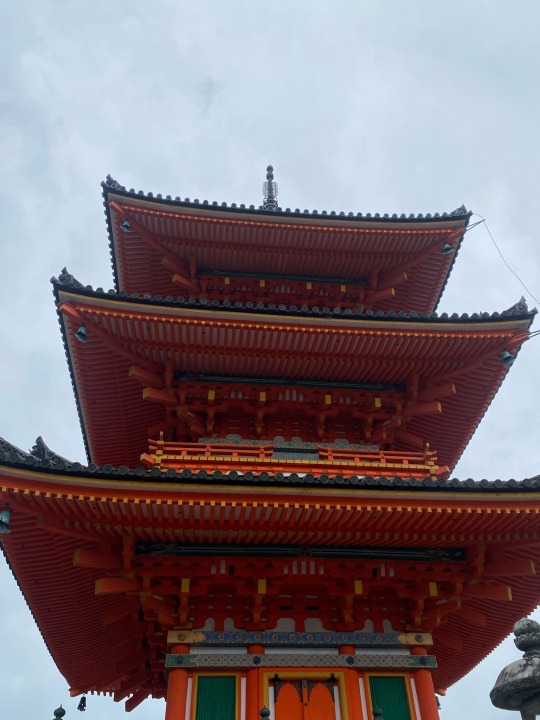


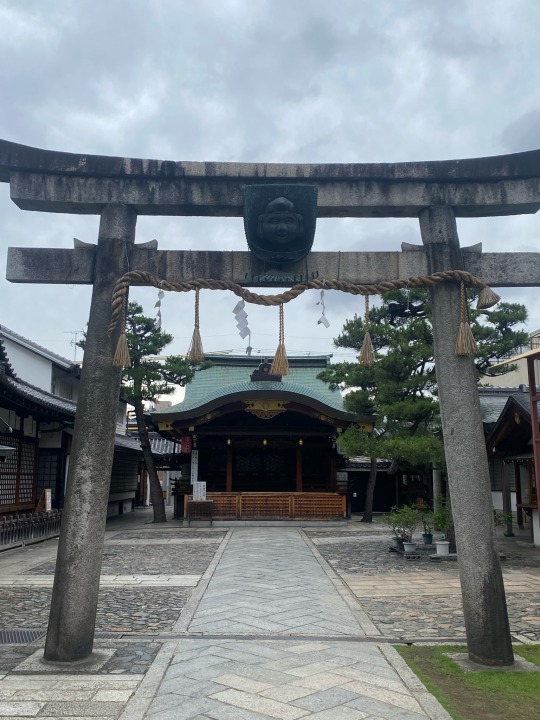
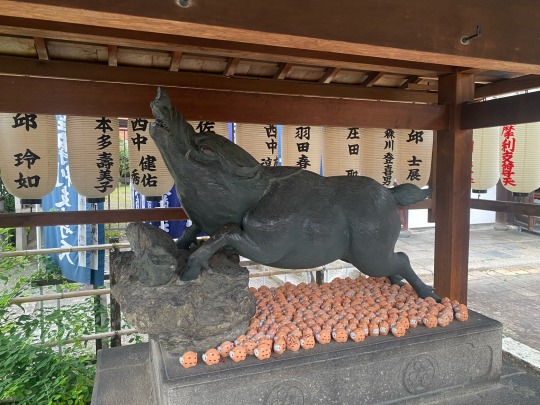
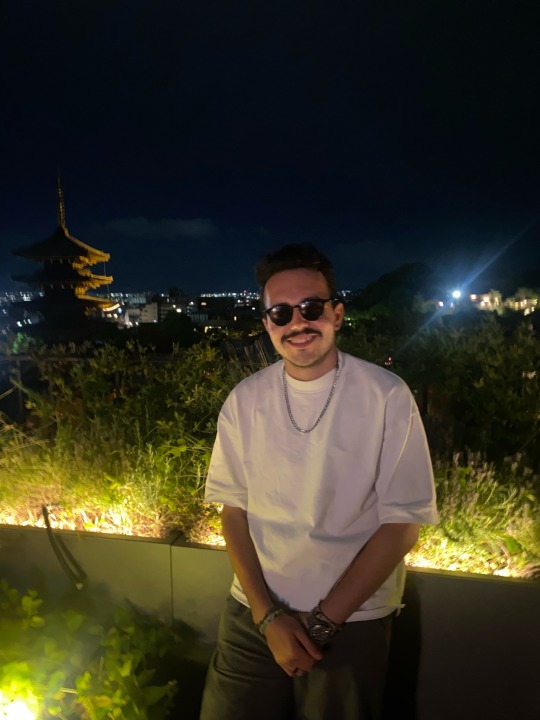
2 notes
·
View notes
Text
June 11 - Himeji-jo
I have sad news to report. Today is the final day of Japanese breakfast. My heart broke when I found out about this. It will be missed. In terms of what we did today, we traveled about 2 hours out of the city of Kyoto to the World Heritage site that is home to Himeji castle. This castle is one of the few structures that has survived the many destructive acts that plagued Japans past, still standing tall in its original glory. I continue to thank myself for purchasing the newest Zelda game as it continues to aid me on our longer train routes. When we arrived at the station we broke up for lunch and I had probably the best Indian food I’ve ever eaten (the price was also godlike). Once I stuffed my face we left for the castle. The structure itself clad in all white was towering, but we were allowed to enter the highest point in the keep which surprised me (most buildings we’ve visited have been inaccessible). The interior (which is now empty) is of high craftsmanship with all the wood (the entire structure is made of wood) covered in a beautiful varnish which makes the floors incredibly smooth. Paying attention to the layout it was clear the entire structure was oriented towards defense as many chokeholds and sharp turns mark the path upwards. Once we arrived at the top the entire city unfolded with large mountains surrounding it in the background. All the walking had me pooped, and I’m not certain but I feel like the sleep here doesn’t get me to 100% each night so I turned in early.
Academic Reflection
While this connects with a previous reading (the one on forestry practices) this castle fully displayed the daimyo’s requirement for large strong trees. Entire pillars in the castle were incredibly thick trunks which showed their age in the rings that were visible. The keep also had 8 flights of stairs so the scale of the structure (and the wood required) is quite massive.
Similarly mirroring the integration of green spaces in Tokyo, this castle was made using the slope of a mountain as part of its construction. The Japanese did this for a number of reasons such as defensibility, and resistance to fire. It’s evident that this willingness to coincide with nature has been present early into Japanese history as opposed to the adversarial nature the US has had with its own nature. While the castle itself lies on a mountain it also borrows design features from nature itself such as sloping and triangular constructions that increase the castles defensibility. However this focus on defense is quite ironic, considering the Tokugawa period (when the castle was reinforced by Ieyasu’s son in law according to a sign at the castle) was known for its peace. Obviously this is a point of hind sight. Todays readings also continued to build on the knowledge surrounding early Japanese urbanization. With the creation of castle towns, economy and populations increased rapidly. Like we’ve read earlier this created a problem for more rural areas as peasants from those regions would attempt to start a new life in the castle town which offered a higher level of prosperity. Interestingly this flight mirrors that which occurs in modern Japan, when a new Shinkansen line opens in a area.
What I personally enjoyed from the readings was furthering my understanding of the social dynamics within ancient Japan. While the daimyo and samurai were still the ruling class, it wasn’t as strict and brutal as a previously believed. Individuals shaped much of the life and culture in ancient Japan and this is evident in the way the cities unfolded. While the daimyo had plans for how they would like their towns to be constructed leeway was afforded to individuals in the construction of their homes and establishments for work.



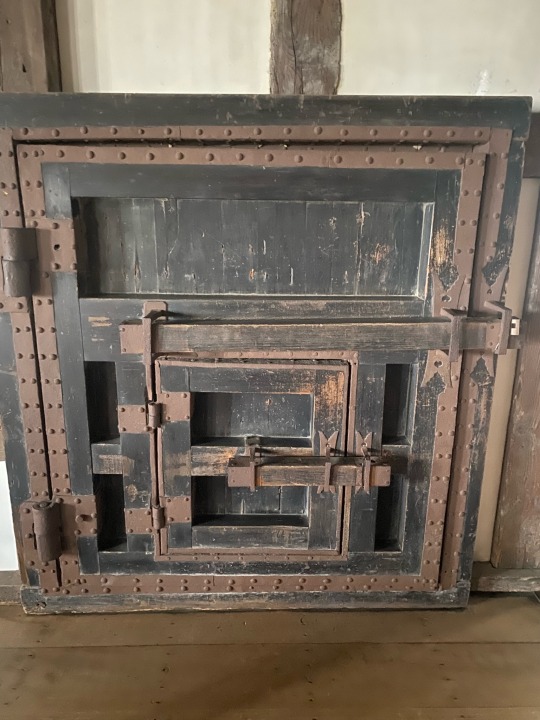

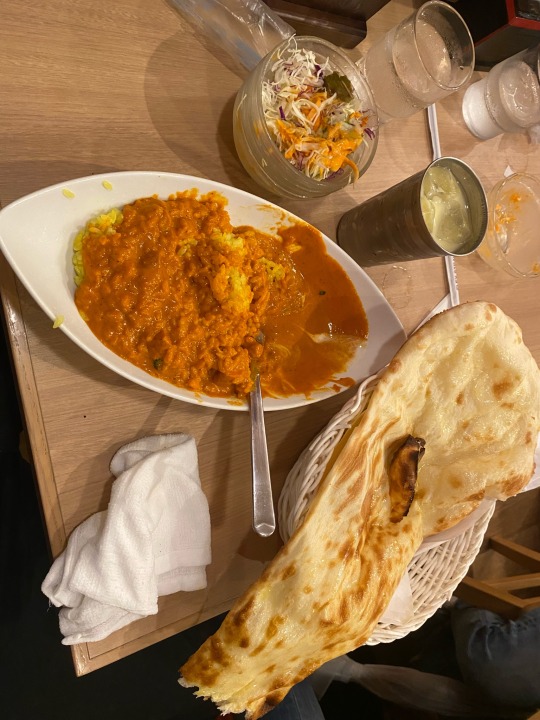
2 notes
·
View notes
Text
June 10 - Kinkakuji and Daitokuji
First night in Kyoto was nice. The futons are significantly better here, so I got a much more comfy sleep. The room is quite small compared to our last hotel but it’s basically just a hovel that I use to store my items and body at night. While the hustle and bustle of Tokyo is hard to replicate, Kyoto is still quite a busy place with transit constantly packed aswell as restaurants. Todays excursions took us to two culturally significant locations the first being the Golden Temple (reconstructed after an arson attack) and the Daisen-In which is a zen garden of high renown. The Golden Temple was nice but the location was more-so a tourist destination so it felt more commodified than previous temple/shrines we have visited. The temple itself, covered completely in gold leaf is inaccessible so we had to look at it from across a small lake. Out of the two locations the Daisen-In was for sure my favorite. Luckily for us a tour guide was there when we arrived and she spoke English. She proceeded to give us in-depth explanations of the significance of the garden aswell as various zen words. She even took us to a room which is usually barred off, which was the quarters of the monk Takuan!! Personally this was a real treat for me as this monk is depicted in my favorite manga Vagabond, and it felt so special to be in the place that he resided in. A specific zen word written by the previous temple head really spoke to me so I purchased a print of it and the very man who wrote it was present!!! He even signed it. What a lucky day.
Feeling at ease I walked the entire distance back to the hotel which was about 4 miles. I soaked in the city of Kyoto on my walk, catching an early glimpse of the Kyoto National Garden which we will visit as a class in a later date.
Academic Reflection
For our reading in the Golden Temple, we read a short excerpt by the famous Japanese author Mishima. These short passages spoke volumes to me, and had a deep emotional impact when I read it. The prose of Mishima was unlike anything I’ve read in recent time, and particularly his musing on the impertinence of life and the path one goes down really struck me. Conflicting with the reading the temple was quite beautiful, but the temple I saw today is a rebuilt version of it after it was burned down. The building itself stood the test of time, avoiding destruction from many years of war which is rare for buildings in Japan as I’ve come to learn. The arsonist is the protagonist of the novel, providing a interesting psychological breakdown of how one reaches absolute dissolution of one’s being.
Our readings pertaining the Zen Buddhism and the gardens they meditate by provided a deeper insight on the very alien practices (alien for a Westerner). The readings described the garden we visited with perfect detail (I was even able to name rocks when our tour guide asked us to guess), and being there after reading on the importance of this location filled me with a strange feeling. Like I was witnessing something wonderful. I’m not really sure how to describe it, maybe the Zen dry garden played its own effects out on me. I think as time passes and I’ve had time to reflect on the experience, I may learn something about myself. It is to early to tell.



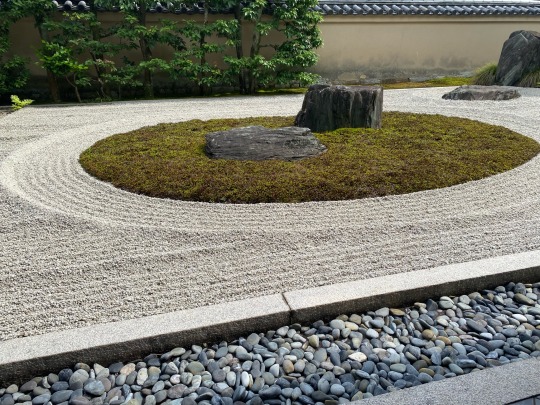

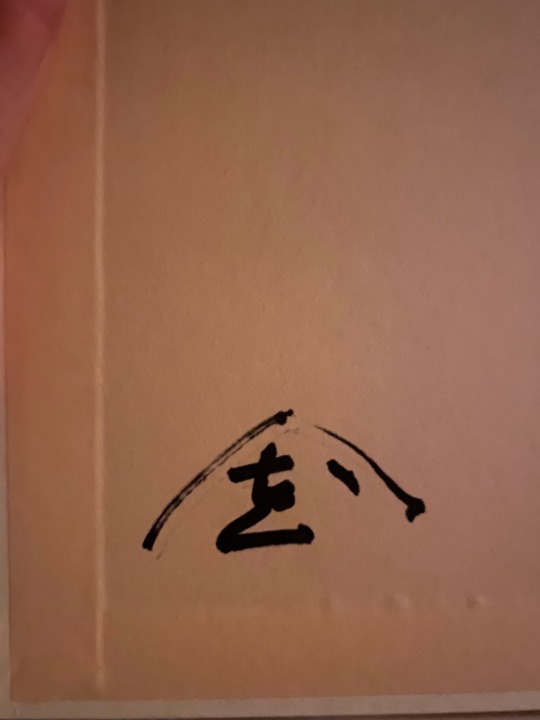
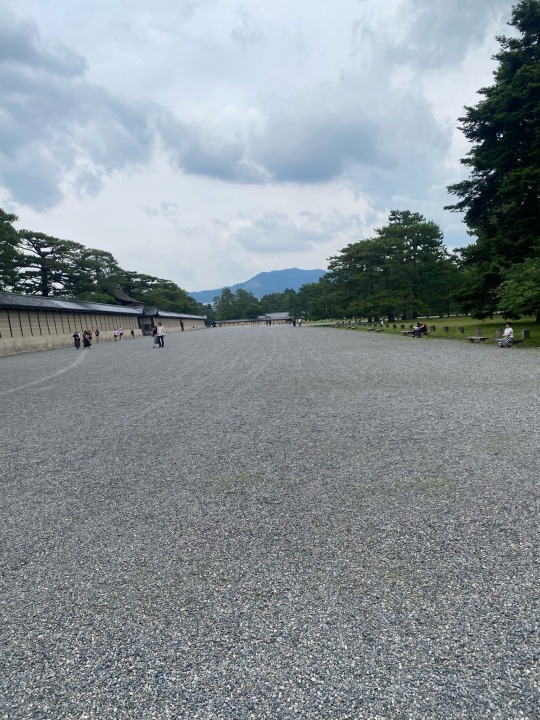
2 notes
·
View notes
Text
June 9 - From Tokyo to Kyoto
Today we traveled from Tokyo to Kyoto via the Shinkansen (Bullet Train). The trip was 2 hours and 30 minutes but went by incredibly fast, although the entire time I was playing the new Legend of Zelda game which is so much fun. The train did go incredibly fast and at times you could feel the pressure on your chest as it pushed you back into the chair. I don’t have much to report on the train itself but I got a cream bread from a bakery at the station and it is probably the best bread I’ve ever eaten. Bread here is significantly better, it’s fluffier and just tastes better. Once we got here, some of my peers didn’t realize that the train doesn’t wait for anyone and we’re to slow to get off. We had to wait for them to come back but thankfully our check in wasn’t for another 2 hours anyways so it was fine. Kyoto itself is gorgeous. The city is quite smaller, but it’s just as lively. The buildings are much smaller so it’s more akin to DC, and the temples that are scattered throughout the city wear a beautiful age. I didn’t do much this afternoon except go to a used bookstore which had almost every manga series imaginable. It was very nice since most of the books were not wrapped (as they are at most bookstores) so I was able to look at the art.
Japanese curry continues to by my favorite meal here.
Academic Reflection
For our reading today we read about the Shinkansen, and the broader implications of its existence throughout Japan. Reading it reminded me quite a bit of what I learned from the metro system in DC with issues such as gerrymandering persisting in Japan as they did in DC. The prosperity it can bring to a city is quite shocking as populations increase, aswell as the number of businesses in areas that have a stop in them. However, after being on it this makes sense as the connectivity it provides throughout the country (and the speed at which it provides that connection) is unparalleled by any other train travel (I’d argue ALL travel) in the world. The amount of people serviced is quite staggering as the train station had the same foot traffic any major airport would have. The Shinkansen is truly a modern wonder of our world.
While eminent domain exists in the United States I was for some reason surprised to find out it also existed here. Interestingly the practice itself, and the responses to said practice are similar as the government tries to acquire land for as cheap as possible while residents will try to squeeze as much money out as they can (which they should). While land in the US is quite expensive, it is even more expensive here so the bill for public transit can get quite large. I wish we had the same willingness to pay for such things in the US as I see no reason a bullet train doesn’t connect the major East Coast cities. Technologies like this should be propagated especially as we continue to enter a worsening climate as the amount of short range flights something like a East Coast bullet train would replace would likely be large.
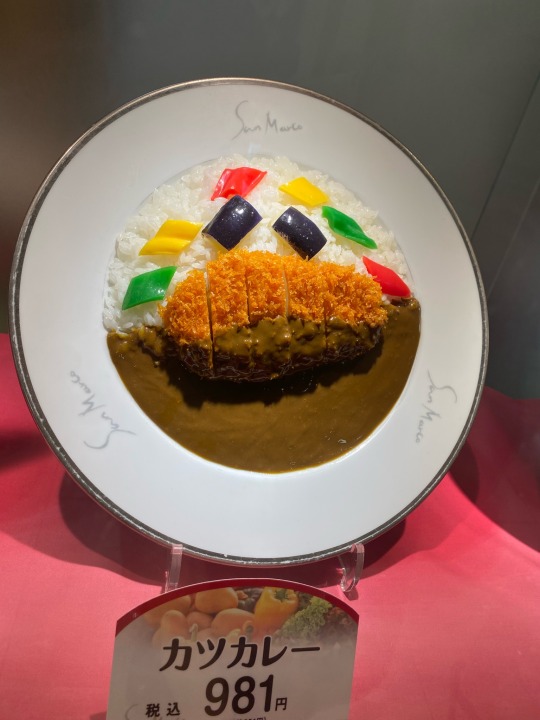

2 notes
·
View notes
Text
June 8 - Final Day in Tokyo
For my final day in Tokyo I didn’t do that much, but I enjoyed the things that have made me fall in love with this city. For breakfast I got a yummy curry bun from 7/11 (Japanese curry is for sure my favorite meal), with a milk tea (which is my favorite drink). I left pretty early for Harajuku/Shibuya which are the two districts I most connected with (it felt like home, in the sense as a place I felt most comfortable in). I just walked around the thrifts, and I actually was able to find real thrift stores with reasonable pricing (I bought a 100$ for 17$). After that I went to a more high end store called Hazy Lazy Planet and purchased some sick remade denim. During the purchase I saw the coolest shoes in my life and decided to treat myself to those as well. I got some yummies (Kebab bowl 😳🤤) before I left and then I just spent the rest of my day relaxing in the hotel. Tokyo was so much fun, but Kyoto will be just as amazing. See you there.



2 notes
·
View notes
Text
June 7 - Mt. Takao
While last days mountain excursion was mainly done on vehicles (our trip up the mountain was on ski rail today), traversing across Takao Mountain was a true treat. After we got off the ski rail we walked a good distance vertically, and along the path we were able to see the beautiful mountainous landscape that spreads out as far as the eye can see. When in the city of Tokyo because of the air pollution a veil clouds these mountains, but being at the peak of the mountain let the scale of land set in. The shrine itself was gorgeous, and my favorite to date. The mountain was originally home to a Shinto shrine, but after an ascetic Buddhist had a vision the kamii god who was enshrined on the mountain was revealed to also be a bodhisattva. As a result along with the Shinto shrine, there is a Buddhist temple. At the Buddhist temple we heard the monks chanting their sutras, and the song was quite beautiful. After reaching the peak with some friends we hiked through one of the trails before merging with the main path. Once we got on the main path Nico, Riki (our guide) and I ran down the mountain (I was in sandals). It was quite a long run but it felt good to get some exercise in after being off for so long. Once we reached the base of the mountain I treated myself to some soft serve! Now I’m going out with some friends to celebrate one of their birthdays. I’m gonna go all out on some nice wagyu steak.
Academic Reflection
Today’s reading dealt with forestry as it pertains to Japan looking as far back to Nara period. No real policy existed until the Tokugawa period, resulting in massive ecological damages that accrued overtime as timber was over exploited with no action taken to let the forest heal. This was issue continued to grow, until it came to a head after the Warring State period, with policy meant to restore the forest being implemented. It should be noted that this policy wasn’t meant to protect nature for the sake of it, and was always viewed through a human centric view (however the Japanese did understand that they needed a healthy environment to be able to live). While policy changed greatly through the Tokugawa what finally became implemented was a series of land use rights surrounding a plantation forestry system which allowed forest to grow back while still remaining productive.
The natural beauty of Japan continues to strike me. Lucious trees cover almost every space that doesn’t have buildings, and it was a result of this focus towards agronomy from an early period in development. I really wish the US would take some notes from Japan on this manner. From the readings the understanding of a healthy forest as almost providing cyclical support for humans and the greater environment so far back in time was surprising and it makes me wonder with the knowledge we have today how we continue to fail nature in this respect. The payoff of this policy was evident in our excursion as almost every surface in the mountain landscape was covered in beautiful green trees. The same could be said for Hakone, except for the ducts of sulfur and the area surrounding that.
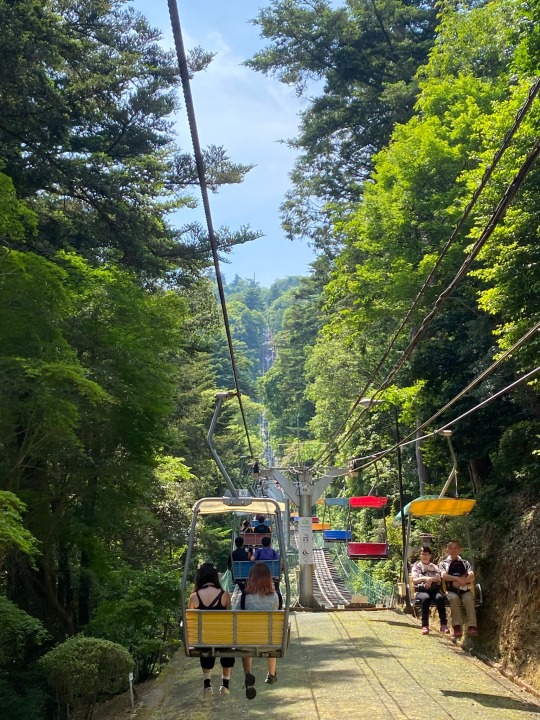


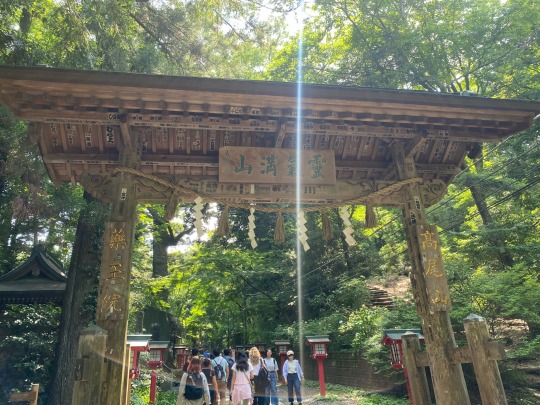

2 notes
·
View notes